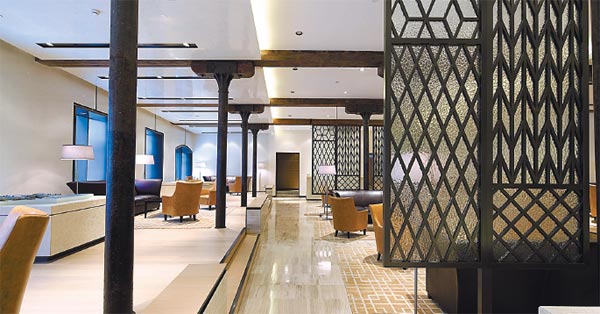
Venetian architect Filippo Gabbiani breathes new life into some of Shanghai's most beloved historic buildings. Rebecca Lo takes a closer look.
 |
|
The sales center of one of Kokai Studios' works in Shanghai, the OCT Suhe Creek project. Photo provided to China Daily |
If Filippo Gabbiani was a car, he'd be Ferrari. The lean Venetian is quick, slick and oozes style, even in a T-shirt and jeans. Based in Shanghai for the past decade, he heads Kokai Studios with his partner, compatriot architect Andrea Destefanis.
|
Related: A skyline all their own |
They are perhaps best known for their work on Bund 18 and 796 Huaihai Lu — two UNESCO Asia Pacific Heritage award-winning buildings that have pioneered how historic buildings in Shanghai are used for contemporary purposes.
"Chinese and Italians are the same," Gabbiani says over coffee while in Hong Kong for meetings.
"For us, everything has a gray area. We are willing to overcome obstacles to get things done. When we started working in Shanghai, we had a hard time at the beginning. There was no respect.
"Now, we form real friendships on the construction sites. Contractors and project managers recommend our work and have become our main sources of referrals."
Gabbiani hails from a family of craftsmen. His paternal grandfather was a spice importer, and he picked up an entrepreneurial spirit from his father’s side. His maternal grandfather was a well-known watercolor painter, and he got his artistic streak from his mother's family.
His mother Marina founded the Venetian crystal company Gabbiani more than four decades ago with the mandate of introducing new designs to the centuries-old technology of making beautiful vases and chandeliers.
"Venetian glassmakers had the best technique but the worst designs," Gabbiani says.
"In the '50s and '60s, Venini — a guy from Milan — brought in a strong school of young designers. They became the top crystal company half a century ago. But their designs became too contemporary. There was no link between traditional technology and new designs."
Marina Gabbiani saw a niche, and her company bridges the gap with products that allude to Venice’s past while fitting into today’s homes and lifestyles.
Gabbiani’s products include its signature red crystal — one of the most difficult colors to produce in the material. Her son Filippo began contributing designs to the Gabbiani collection while he was still at school.
"Venice is a decayed city — like a Disneyland," Gabbiani says.
"There is no way to save it. I love the city and will always consider it my home. I’ll get married there, and my kids will grow up knowing it by living there.
"But it's difficult working in Venice. It's fantastic as a resource for construction and technology, such as learning how to apply plaster or work with terrazzo. Yet it’s a very conservative city."
Gabbiani has always approached design from a multidisciplinary perspective. Although he studied architecture at the University of Venice, he considered school a side endeavor while he worked on various projects.
